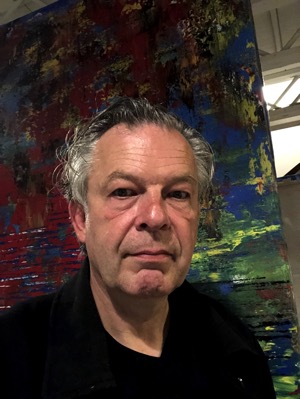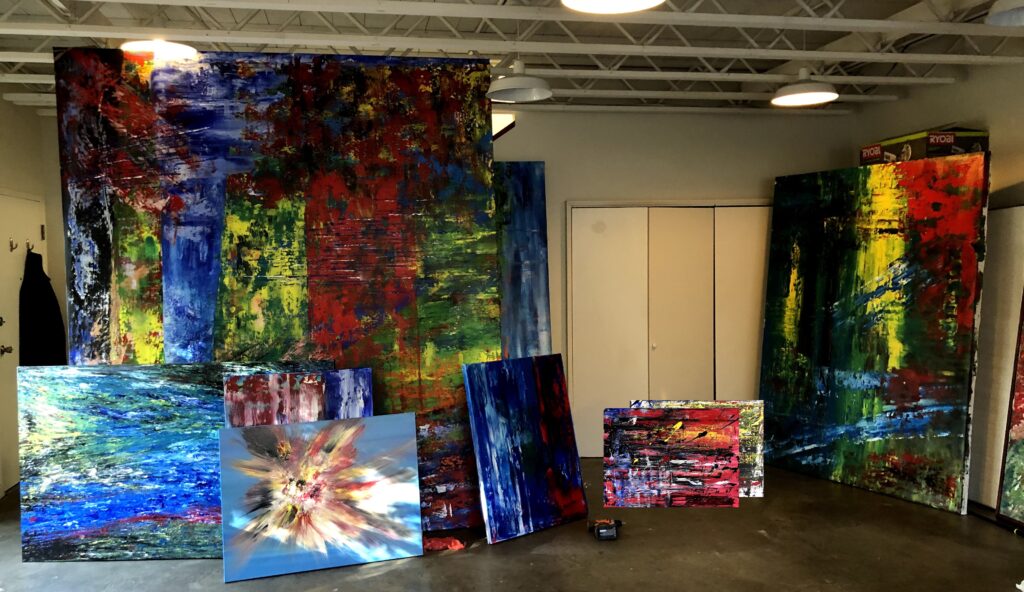

Artistic Journey
John Bernard is a figure of intrigue and depth in the contemporary art scene, a German-born artist whose pursuits have spanned the realms of science, entrepreneurship, and most pivotally, abstract art. Residing now in California, Bernard’s journey is a chronicle of rigorous exploration and profound personal evolution, marked by a relentless quest for an artistic voice that truly resonates with his diverse experiences.
Beginnings
“It’s always good to remember where you are coming from – but it’s better if you never want to forget. I had the privilege and luck to be raised by wonderful parents in a wonderful home.”
Born and raised in Aachen at the very border to Belgium and the Netherlands, Bernard developed an early talent and passion for art and photography in school and at home.
Paris and the big art bang
A more important formative dive of Bernard into the arts took place in Paris, a city synonymous with artistic revolution and historical depth. Studying the classical modern and the art of Salvador Dali and Pablo Picasso, Bernard was exposed to a spectrum of artistic philosophies and techniques. These experiences laid the foundational stones of his artistic ideas, steeped in the traditions of classical modernism but destined for transformation.
Photo-Realistic Abstraction
Originally also a practitioner of classical oil painting and drawing, Bernard’s early works were partly characterized by a strict adherence to the representational form. These pieces, meticulous and evocative, crafted with the precision of a trained draftsman competed with a burgeoning curiosity for more liberated forms of expression.
He experimented in a similar way also with photographie and photo realismn only to transform both eventually into a new style which he name saked photo-realistic-abstration. Bernards “human genome project” and “action painting” series are standing for this style and innovation.
Colors and textures without contours
In addition to photo-realistic abstraction, which continues to rely on contours and contrasts, at least in the sense of a figurative connotation, contourless color abstraction is another passion and just as conscious a focus as photorealistic abstraction. This focus was not impulsive either, but the result of years of development with many experiments and inner conflicts. Abstract art, with its emphasis on color and texture without contours over representative accuracy, offered the opportunity to completely break free from the constraints of predetermined visual messages. The idea behind it is both simple and philosophical. It must be possible to experience a work of art without wanting to recognize something learned in it or immediately asking for its meaning. In this sense, the colorful abstract composition has no conceptual effect for Bernard, but a purely emotional one.
California
In California, Bernard’s studio became a sanctuary where these abstract ideas were nurtured into vast vibrant canvases, marked by an orchestration of color and a deliberate chaos of forms. His compositions, often large-scale, invite viewers to lose themselves in the visual landscapes he creates—landscapes that challenge the eye to move beyond familiar interpretations and to engage with emotion and introspection.
Publishing under a pseudonym
Despite his significant artistic achievements, Bernard has chosen to present his art under a pseudonym. This decision stems from a nuanced understanding of the biases prevalent in scientific and business domains—fields in which he is also deeply embedded as a nuclear physicist and a tech entrepreneur. By compartmentalizing his identities, Bernard protects his artistic career from being compromized by his scientific background and business accomplishments and vice versa, ensuring that each can be appreciated in its own right.
Reflections
Bernard’s work has once in a while drawn comparisons to that of Gerhard Richter. Though both artists share a profound commitment to abstraction, their approaches and inspirations are uniquely their own. Bernard’s path to abstraction was self-forged, inspired by his diverse experiences and personal revelations rather than the influence of his contemporaries. Similarities while aesthetically possible are coincidental. Bernard sees abstract art as a vehicle for exploring the intrinsic beauty and chaos of visual elements.
Now and next
Expanding further on his artistic philosophy, Bernard often discusses the concept of abstraction as a form of ultimate freedom—a space where the artist and viewer alike can encounter pure experience unbounded by preconceived notions or societal labels. This philosophy not only informs his artistic output but also permeates his public discussions and writings, which are enriched with insights drawn from his scientific background.
As John Bernard continues to evolve both as an artist and a thinker, his works serve not only as artifacts of his personal journey but also as invitations to the viewer to reconsider the role of art in society. They prompt a dialogue on the value of abstraction, not just as an aesthetic choice but as a profound mode of human expression—connecting the seen with the unseen, the known with the mysterious.
Bernard’s artistic evolution, his philosophical stances, the dialogues, and his works inspire and provide a richer, more textured understanding of this multifaceted art and the complexities of navigating multiple worlds.


